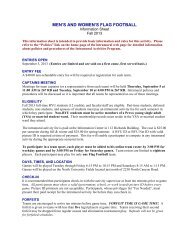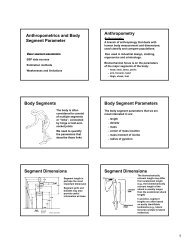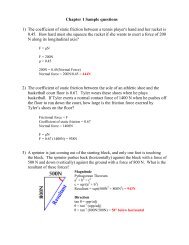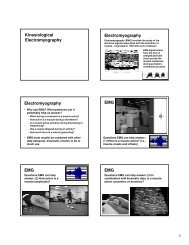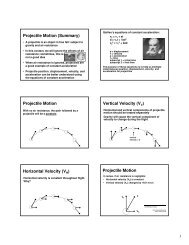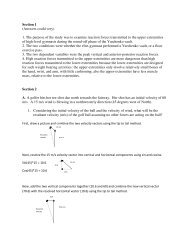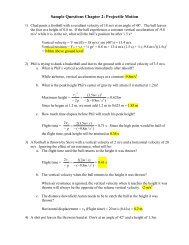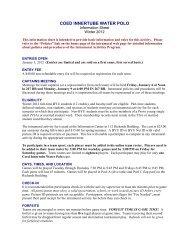Anthropometrics/Body Segment Parameters
Anthropometrics/Body Segment Parameters
Anthropometrics/Body Segment Parameters
Create successful ePaper yourself
Turn your PDF publications into a flip-book with our unique Google optimized e-Paper software.
<strong>Segment</strong> Mass<br />
• <strong>Segment</strong> mass is a<br />
quantitative indicator of a<br />
segment’s inertia<br />
• Determine by segment<br />
density and volume<br />
• For many segments<br />
density can be estimated<br />
from literature data, and<br />
volume can be measured<br />
<strong>Segment</strong> Mass<br />
• Tables also exist that allow one to predict<br />
segment masses, usually as a percentage of<br />
whole body mass<br />
• Finally, the volume represented by different<br />
tissues (fat, muscle, bone) can also be<br />
determined using modern imaging/scanning<br />
techniques (MRI, CT, DEXA)<br />
• These volumes can be combined with more<br />
accurate individual tissue densities to yield<br />
good estimates of segment mass<br />
Center of Mass (COM)<br />
• <strong>Body</strong> segments are made up of an immense<br />
number of distributed mass particles<br />
• Mechanical analysis is facilitated by<br />
identifying the COM: a single point about<br />
which the mass is equally distributed (i.e.,<br />
the balance point)<br />
• Typically specified as a distance (% of<br />
segment length) relative to some unique<br />
point (e.g. proximal joint center)<br />
<strong>Segment</strong>al COM<br />
The location of the COM can be defined as<br />
follows:<br />
x 1<br />
m 1 m 2 m 3<br />
x 2<br />
x 3<br />
X<br />
M<br />
M X = Σ m i x i so X = Σ m i x i<br />
M<br />
<strong>Segment</strong>al COM<br />
The COM of an object can be determined using<br />
a “reaction board”<br />
COM is found by knowing that all moments<br />
about the knife edge must sum to zero<br />
<strong>Segment</strong>al COM<br />
cog = X<br />
X<br />
cog = Y<br />
Y<br />
prox<br />
prox<br />
+ L%(X<br />
+ L%(Y<br />
dist<br />
dist<br />
- X<br />
- Y<br />
prox<br />
prox<br />
)<br />
)<br />
The x and y coordinates for the<br />
right shoulder of a female tennis<br />
player are . The x and y<br />
coordinates for the elbow are<br />
. What is the location of<br />
the center of gravity of the upper<br />
arm?<br />
should be at<br />
knife edge<br />
2




